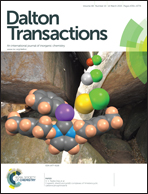A label-free colorimetric sensor for Pb2+ detection based on the acceleration of gold leaching by graphene oxide
Abstract
In this work, we developed a novel, label-free, colorimetric sensor for Pb2+ detection based on the acceleration of gold leaching by graphene oxide (GO) at room temperature. Gold nanoparticles (AuNPs) can be dissolved in a thiosulfate (S2O32−) aqueous environment in the presence of oxygen; however, the leaching rate is very slow due to the high activation energy (27.99 kJ mol−1). In order to enhance the reaction rate, some accelerators should be added. In comparison with the traditional accelerators (metal ions or middle ligands), we found that GO could efficiently accelerate the gold leaching reaction. Kinetic data demonstrate that the dissolution rate of gold in the Pb2+–S2O32−–GO system is 5 times faster than that without GO at room temperature. In addition, the effects of surface modification and the nanoparticle size on the etching of AuNPs were investigated. Based on the GO-accelerated concentration-dependent colour changes of AuNPs, a colorimetric sensor for Pb2+ detection was developed with a linear range from 0.1 to 20 μM and the limit of detection (LOD) was evaluated to be 0.05 μM. This colorimetric assay is simple, low-cost, label-free, and has numerous potential applications in the field of environmental chemistry.


 Please wait while we load your content...
Please wait while we load your content...